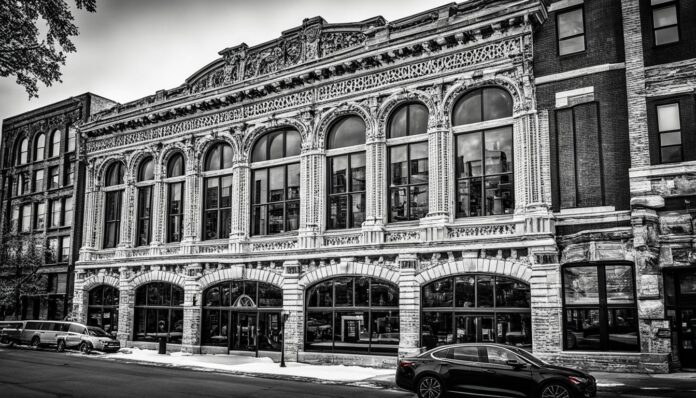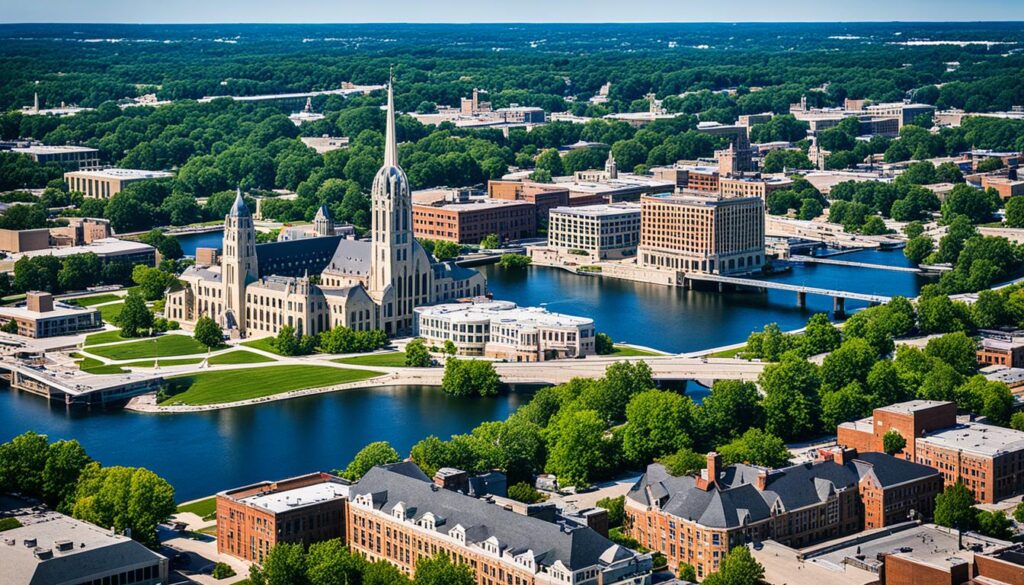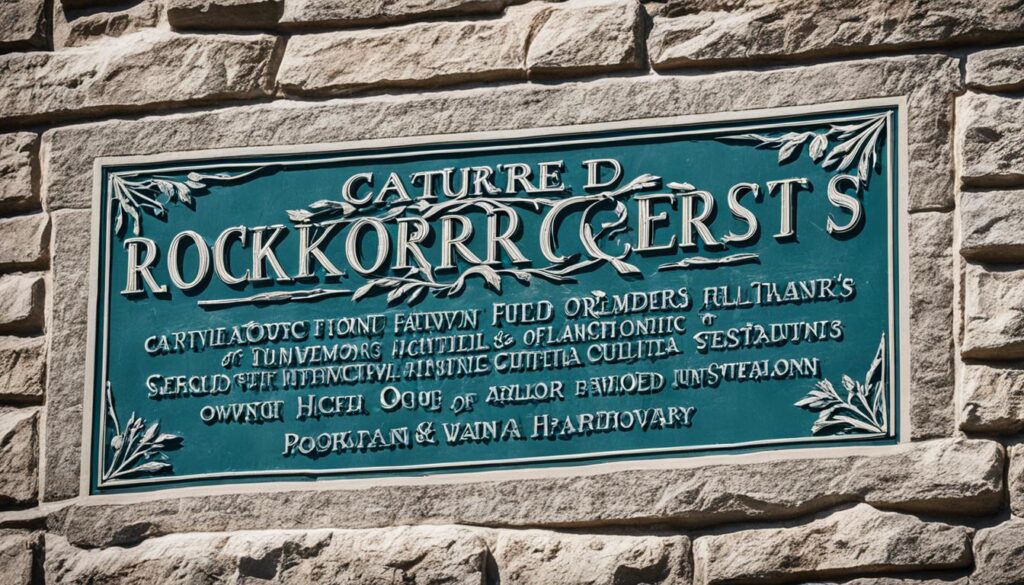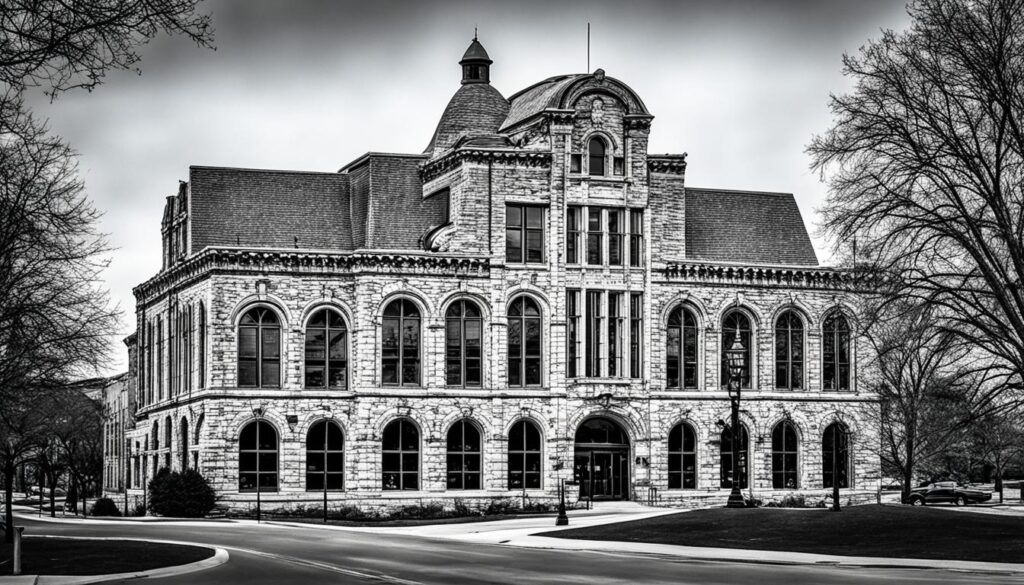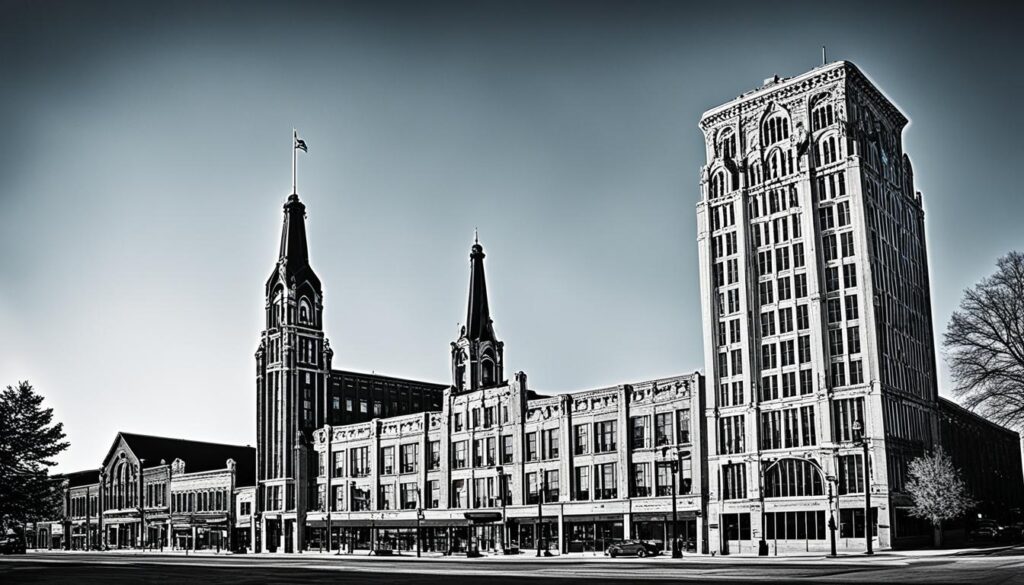Have you ever wondered how a city’s architecture can tell a story of its past? In Rockford, Illinois, the historic architecture weaves a tale of rich heritage and timeless beauty. From towering landmarks to charming residential buildings, each structure is a testament to the city’s architectural legacy. But how did these gems come to be? And what secrets do they hold?
Join us as we embark on a journey through Rockford’s fascinating world of historic architecture. Explore iconic landmarks, uncover hidden gems, and immerse yourself in the captivating stories behind each architectural masterpiece. Brace yourself for awe-inspiring designs, intricate detailing, and a deeper understanding of Rockford’s cultural identity.
Uncovering Rockford’s Architecturally Significant Sites
Embark on a captivating journey through Rockford’s architectural history as we explore the city’s most notable landmarks. Immerse yourself in the rich tapestry of Rockford’s past, where historic landmarks and architecturally significant sites tell stories of grandeur, resilience, and cultural heritage.
Discover the distinct features and unique stories behind each architectural gem that has shaped Rockford’s skyline. From majestic churches to grand government buildings, each structure offers a glimpse into the city’s rich architectural heritage.
“Architecture is a visual art, and the buildings speak for themselves.” – Julia Morgan
Let’s begin our exploration with some of the most prominent and historically significant landmarks in Rockford:
1. Coronado Performing Arts Center
Experience the timeless elegance of the Coronado Performing Arts Center. Built in 1927, this magnificent theater showcases stunning Spanish Renaissance architecture and continues to host captivating performances and events.
2. Laurent House
Step inside the only home designed by famed architect Frank Lloyd Wright in Illinois specifically for a client with physical disabilities. The Laurent House showcases Wright’s innovative and forward-thinking approach to accessible design.
3. Tinker Swiss Cottage Museum
Explore the Victorian-style Tinker Swiss Cottage Museum, a historic house museum that provides a rare glimpse into the life of one of Rockford’s early settlers. Witness the intricate architecture and interior design, surrounded by stunning wooded landscapes.
4. Rockford City Hall
Marvel at the neoclassical beauty of Rockford City Hall, a prominent government building that has served as a symbol of civic pride and heritage since its completion in 1905. Its ornate architecture and grandeur reflect the city’s rich history and community spirit.
5. Midway Village Museum
Travel back in time to experience life in early Rockford at the Midway Village Museum. Explore meticulously restored structures, including a Victorian-era village, rural farmstead, and immersive exhibits that paint a vivid picture of Rockford’s past.
Continue your architectural journey through Rockford as we uncover more hidden treasures and delve deeper into the vibrant history that shaped this remarkable city.
Exploring Rockford’s Historical Buildings
Step back in time and embark on a captivating journey through the historical buildings that have shaped Rockford’s landscape. As you wander through the city, you’ll encounter a rich tapestry of architectural styles that span different eras, providing glimpses into Rockford’s vibrant past. These beautifully preserved structures not only tell stories of the city’s history but also serve as reminders of the architectural prowess that once flourished in Rockford.
From the grandeur of neoclassical facades to the ornate detailing of Victorian mansions, Rockford’s historical buildings evoke a sense of awe and wonder. Each structure reflects the unique architectural styles and design philosophies prevalent during its time of construction, showcasing the creativity and craftsmanship of the architects and builders who brought them to life. By exploring these historical buildings, you can gain a deeper appreciation for the city’s architectural heritage and the skill and vision that went into creating these remarkable landmarks.
Witness the City’s Evolution Through Architecture
Rockford’s historical buildings provide a tangible connection to the city’s evolution over the years. From the charming brick buildings of the early 19th century to the sleek modernist designs of the mid-20th century, each structure offers a glimpse into the changing architectural trends and societal influences that have shaped Rockford’s identity.
As you wander through the streets, you may come across iconic structures such as the Coronado Theatre, a grand Spanish Renaissance Revival theater that has been enchanting audiences since 1927. Its opulent interiors and stunning architecture are a testament to the city’s commitment to preserving its architectural treasures.
“Rockford’s historical buildings are not just bricks and mortar; they are living testaments to our past. They are the tangible reminders of the stories, people, and events that have shaped our city. Explore them, admire them, and let them transport you to a time gone by.”
Another notable example is the Tinker Swiss Cottage, an enchanting mansion built in the late 19th century. With its distinctive Swiss chalet-style architecture and beautifully landscaped gardens, it offers visitors a glimpse into the lives of Rockford’s early settlers and the exquisite craftsmanship of the era.
Preserving Rockford’s Architectural Splendors
Preservation efforts by organizations and passionate individuals have ensured that Rockford’s historical buildings remain intact, allowing future generations to appreciate and learn from their architectural splendor. These structures play a crucial role in fostering a sense of pride and identity among Rockford’s residents, while also attracting visitors who are drawn to the city’s rich historical and cultural heritage.
The architectural diversity showcased through Rockford’s historical buildings is a testament to the city’s vibrant past and a testament to the vision and creativity of the architects and craftsmen who shaped its streets. By exploring these architectural gems, you can gain a deeper understanding of Rockford’s history and the profound impact that architecture can have on a community.
Rockford Architecture Tours: A Closer Look at the City’s Landmarks
Immerse yourself in the rich architectural heritage of Rockford by embarking on a guided architecture tour. Discover the intricate details and fascinating stories behind the city’s landmarks as you gain expert insights into their design, construction, and historical significance.
Rockford architecture tours offer a unique opportunity to explore the city’s architectural gems up close. Led by knowledgeable guides, these tours take you on a journey through time, showcasing the diverse architectural styles that have shaped Rockford’s skyline.
During the tour, you’ll have the chance to admire the stunning craftsmanship and attention to detail that went into creating each landmark. From ornate facades to innovative structural elements, every architectural feature reveals the passion and skill of the builders and architects who left their mark on Rockford’s urban landscape.
Whether you’re a history enthusiast, an architecture lover, or simply curious about the city’s heritage, Rockford architecture tours provide a comprehensive and captivating experience. You’ll gain a deeper understanding of Rockford’s cultural identity and the significance of its architectural treasures.
Join us on a journey through Rockford’s architectural history and witness the evolution of the city’s design sensibilities. Step inside iconic buildings, explore hidden gems, and uncover the stories that have shaped Rockford’s built environment.
Highlights of a Rockford Architecture Tour:
- Visit iconic landmarks such as the Coronado Performing Arts Center, a stunning example of the Spanish Mission Revival style.
- Explore the Frank Lloyd Wright-designed Laurent House, an architectural masterpiece that showcases the principles of organic architecture.
- Discover the intricate stained glass windows and soaring vaulted ceilings of the First Presbyterian Church of Rockford.
- Marvel at the Rockford Trust & Savings Bank building, an elegant Beaux-Arts-style structure that once served as a symbol of prosperity.
- Experience the beauty of the Laurent House, the only Usonian-style home in Illinois designed by Frank Lloyd Wright.
Rockford architecture tours offer a truly immersive experience, allowing you to appreciate the city’s architectural heritage from a fresh perspective. Whether you’re a local resident or a visitor, these tours will leave you with a deeper appreciation for Rockford’s unique blend of history, art, and culture.
| Tour Name | Duration | Meeting Point |
|---|---|---|
| Historic Downtown Architectural Tour | 2 hours | Main Street Plaza |
| Frank Lloyd Wright Tour | 3 hours | Laurent House Foundation |
| Churches and Cathedrals Tour | 2.5 hours | First Presbyterian Church of Rockford |
| Industrial Heritage Tour | 3.5 hours | Midway Village Museum |
Protecting the Past: The Preservation of Rockford’s Historic Architecture
Preservation of historic architecture is essential in maintaining the cultural and historical identity of a city. In Rockford, dedicated efforts are made to protect and safeguard the invaluable architectural treasures that have withstood the test of time. Conservation plays a crucial role in not only preserving the physical structures but also in fostering a deep appreciation for Rockford’s unique character.
Historic buildings serve as tangible connections to the past, offering glimpses into the lives and stories of those who came before us. These architectural marvels narrate Rockford’s history and embody the spirit of its communities. Through proactive preservation initiatives, Rockford ensures the longevity of these valuable assets for future generations to enjoy and learn from.
The preservation of historic architecture in Rockford involves a multifaceted approach that combines meticulous restoration, adaptive reuse, and community engagement. By adhering to strict architectural standards, skilled craftsmen and preservationists are able to restore aging structures to their former glory, showcasing the architectural brilliance and craftsmanship of yesteryears.
Preserving historic architecture allows us to honor the past and create a sense of continuity in our rapidly changing world. It provides a visual reminder of our roots and fosters a sense of pride and identity within the community.
The Role of Conservation and Stewardship
- Conservation: Conservation efforts aim to maintain the authenticity and integrity of historic buildings. This involves carefully researching and replicating original construction techniques, using compatible materials and methods to ensure historical accuracy.
- Stewardship: The community’s involvement is crucial in the preservation of historic architecture. By raising awareness and fostering a sense of responsibility, individuals can become stewards of Rockford’s architectural heritage, actively participating in its protection and maintenance.
Preserving historic architecture not only benefits the community culturally but also economically. Heritage tourism flourishes in cities with well-preserved architectural gems, attracting visitors and stimulating the local economy. Rockford’s commitment to preserving its historic architecture is a testament to its forward-thinking approach, recognizing the intrinsic value and economic potential of these assets.
By investing in the preservation of historic architecture, Rockford ensures that future generations can experience the beauty, charm, and historical significance embodied within the city’s architectural fabric. The legacy of Rockford’s past becomes an enduring gift that enriches the present and inspires the future.
| Benefits of Historic Architecture Preservation in Rockford | Challenges in Preserving Historic Architecture in Rockford |
|---|---|
|
|
Despite these challenges, Rockford remains steadfast in its commitment to the preservation of its historic architecture. Through collaborative efforts between governmental organizations, preservation societies, and passionate individuals, Rockford continues to protect its architectural legacy and celebrate the vibrant stories woven within its walls.
Tracing Rockford’s Architectural History
Embark on a fascinating journey through the architectural history of Rockford, as we trace the influences and trends that have shaped the city’s built environment. From the early settlers to modern-day architects, each era has left its unique imprint on Rockford’s architectural landscape.
Perhaps the most influential period in Rockford’s architectural history is the late 19th century, when the city experienced rapid growth and prosperity. During this time, Rockford saw the rise of magnificent structures, showcasing a blend of architectural styles, including Victorian, Queen Anne, and Italianate.
Architectural milestones in Rockford:
1. The Emerson House: This grand Victorian mansion, built in 1856, is a testament to Rockford’s early architectural charm. Its distinctive tower, intricate woodwork, and ornate detailing make it an iconic landmark in the city.
2. Midway Village Museum: Step back in time at this living history museum, which features well-preserved buildings representing different architectural periods in Rockford’s history. Explore the Victorian-era museum village and gain a deeper understanding of the city’s architectural evolution.
3. Laurent House: Designed by renowned architect Frank Lloyd Wright, the Laurent House is a masterpiece of Usonian architecture. This iconic residence reflects Wright’s innovative design principles and showcases Rockford’s contribution to the modern architectural movement.
The architectural styles in Rockford continued to evolve in the 20th century, with the introduction of Art Deco, Prairie School, and International Style. These styles can be seen in various buildings, including churches, government structures, and commercial establishments.
Today, Rockford continues to embrace its architectural heritage while also embracing new architectural trends. The city’s revitalization efforts have led to the adaptive reuse of historic buildings, transforming them into vibrant spaces for living, working, and leisure.
As you explore Rockford’s architectural history, you’ll gain a deeper appreciation for the city’s rich cultural heritage and the individuals who contributed to its unique identity.
Iconic Architecture in Rockford: Structures That Define the City
When it comes to iconic architecture, Rockford boasts a collection of structures that have become synonymous with the city’s identity. These architectural marvels have left an indelible mark on Rockford’s skyline and collective memory, representing the city’s rich heritage and cultural significance.
One such iconic landmark is the Coronado Performing Arts Center. This historic theater, built in 1927, is not only known for its stunning Spanish Renaissance Revival architecture but also for hosting a wide range of performances, including Broadway shows and musical concerts. Its exquisite design and grandeur make it a cherished symbol of Rockford’s artistic and cultural heritage.
Another notable architectural gem is the Laurent House. Designed by the renowned American architect Frank Lloyd Wright, this house is the only building in Illinois that he ever designed for a disabled client. The Laurent House showcases Wright’s signature organic architecture, seamlessly blending the structure with its surrounding natural environment. This iconic residence is a testament to Wright’s genius and the innovative spirit of Rockford.
Rockford City Hall is yet another structure that defines the city’s architectural landscape. This elegant building, constructed in the Beaux-Arts style, stands as a symbol of civic pride and governance. With its imposing presence and intricate detailing, Rockford City Hall has served as a seat of power and a focal point for the community since its completion in 1905.
“The iconic architecture in Rockford beautifully captures the essence of the city’s history and character, reminding us of the remarkable architectural talent and innovation that has shaped the city over the years.”
Rockford Art Museum also deserves a mention among Rockford’s iconic architectural structures. Situated on the banks of the Rock River, this modernist masterpiece designed by the renowned architect Ben Weese offers a breathtaking juxtaposition of contemporary design against the natural beauty of its surroundings. The museum’s unique architectural form and its commitment to showcasing exceptional contemporary art make it a must-visit destination for art enthusiasts.
As you explore Rockford, keep an eye out for these notable landmarks and architectural treasures. They not only reflect the city’s architectural heritage but also serve as a constant reminder of the artistry and ingenuity that have defined Rockford throughout its history.
Safeguarding Rockford’s Architectural Heritage: The Importance of Preservation
Preserving the historic architecture of Rockford is of utmost importance, not only for honoring the city’s rich heritage but also for sustaining its cultural and economic vitality. The architectural heritage of Rockford reflects the stories of its people, the events that shaped the community, and the unique character that sets it apart. By safeguarding these architectural treasures, we ensure that future generations can continue to appreciate and learn from them.
The preservation of historic architecture in Rockford brings forth a plethora of benefits. Firstly, it allows us to maintain a tangible connection to the past, offering glimpses into the architectural styles, craftsmanship, and design principles of different eras. Historical buildings serve as living evidence of the city’s evolution, allowing us to better understand and appreciate its history.
Moreover, the preservation of Rockford’s architectural heritage contributes to the overall aesthetic beauty of the city. These structures, with their intricate details and unique designs, add charm to the urban landscape and create a sense of place. The architectural gems scattered throughout Rockford serve as landmarks that define the city, making it recognizable and memorable.
Preservation efforts also play a significant role in attracting tourism and boosting the local economy. Historic buildings often become popular tourist destinations, attracting visitors who are captivated by the stories and history they hold. As tourists explore Rockford’s architectural wonders, they contribute to the local economy by dining, shopping, and staying in the area. In this way, preservation becomes an integral part of the city’s economic growth.
However, preserving historic architecture does come with its challenges. Balancing the need for preservation with the demands of urban development can be a delicate act. As cities grow and evolve, pressures for new construction and modernization can pose threats to historical buildings. Striking a balance between the preservation of architectural heritage and the need for progress requires careful planning, collaboration, and community engagement.
“Every time an old building is torn down and replaced with a new one, we lose a piece of history, a piece of our cultural identity. Preserving our architectural heritage is a responsibility we owe to future generations.”– John Anderson, preservation advocate
The Challenges of Preservation
- Financial constraints: Maintenance and restoration of historic buildings can be expensive.
- Ownership issues: Determining responsibility and securing funding for preservation efforts.
- Lack of public awareness: Educating the community about the significance of preserving architectural heritage.
- Finding adaptive reuse opportunities: Repurposing historical buildings to meet modern needs.
The Benefits of Preservation
- Cultural appreciation: Preserving architectural heritage allows us to connect with our past and celebrate our cultural identity.
- Economic growth: Historic preservation attracts tourism and boosts the local economy.
- Sustainable development: Preservation promotes the reuse of existing resources, reducing the environmental impact of new construction.
- Community pride: Historic buildings instill a sense of pride and belonging among residents, creating a strong community identity.
By recognizing the value of preserving Rockford’s architectural heritage and addressing the challenges that come with it, we can ensure that the city’s historic buildings continue to stand as lasting symbols of its rich history and vibrant culture.
Conclusion
In conclusion, Rockford’s historic architecture stands as a testament to the city’s rich history and cultural heritage. Each building, from grand landmarks to humble residential structures, tells a unique story and contributes to the tapestry of Rockford’s past.
Embarking on a journey through time, you’ll be captivated by the beauty and craftsmanship of Rockford’s architectural marvels. These structures not only reflect the architectural styles and influences of their time but also serve as landmarks that define the city’s identity.
Preserving Rockford’s architectural heritage is of utmost importance, as it ensures that future generations can appreciate and learn from the city’s past. These historical buildings provide a link to Rockford’s roots and serve as reminders of the community’s progress and growth over the years.




























